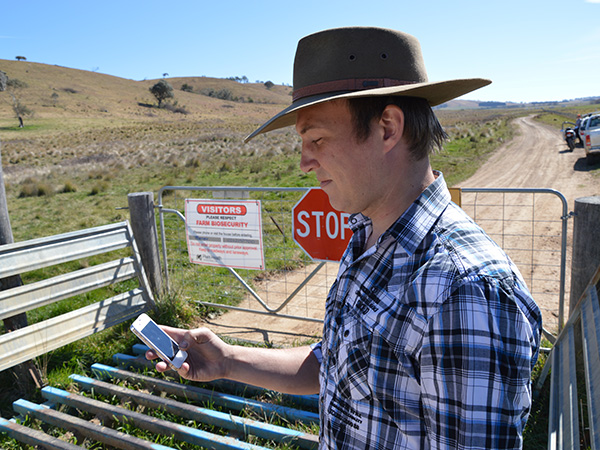Farm biosecurity is central to good land management
By the Farm Biosecurity team
By implementing simple biosecurity measures in your day-to-day operations, you will improve your own biosecurity and that of your region, while minimising production losses and unnecessary costs.
That’s the key message for producers from the Farm Biosecurity project, a joint initiative of Animal Health Australia (AHA) and Plant Health Australia.

The FarmBiosecurity mobile app makes it easier for producers to incorporate farm biosecurity into their everyday activities.
The project’s goal is to equip producers with key information they need to reduce the risks posed by diseases, pests and weeds to crops and livestock, said Dr Simon Humphrys, AHA’s Executive Manager of Biosecurity and Product Integrity Services.
“It does this primarily through its website, which is a hub of on-farm biosecurity information. From industry plans to farm manuals to animal health declarations and biosecurity checklists, there are plenty of resources to help producers implement on-farm biosecurity practices. We really want to make it as easy as we can for farmers to set themselves up for success,” said Dr Humphrys.
“We’ve also developed videos on the six biosecurity essentials and the FarmBiosecurity mobile app to make it even easier for producers to incorporate farm biosecurity into their everyday activities.”
The app allows producers to access a range of information on potential biosecurity risks, view suggested management strategies and build a plan specific to their property. This information stays with them in their pocket, making it a valuable resource for planning and risk assessment.
Producers can download the FarmBiosecurity app on the App Store or Play Store.
Why practice biosecurity on-farm?
Biosecurity is central to good land management. Endemic and emerging disease, pest and weed threats are a huge concern to producers in affected areas. Limiting their impacts is a national priority across all agricultural industries.
“From large agricultural companies to hobby farmers – everyone has to pull together so that land is as productive, healthy and well protected as it can be” said Dr Humphrys.
Farm Biosecurity regularly surveys producers to find out how they think about on-farm biosecurity. Successive surveys have shown that a majority of producers really get the importance of biosecurity and how it benefits not only individual farms, but also the surrounding regions and wider industry.
“It’s really valuable for us to know what we are doing that works for producers and what we can add to the toolkit so that the Farm Biosecurity project continues to deliver good outcomes for producers and industries as a whole,” said Dr Humphrys.
In 2017, nearly 60 percent of producers surveyed answered ‘controlling diseases, pests and weeds’ when asked to define biosecurity – up from less than 40 percent when this question was first asked in 2010. Likewise, freedom from threats was considered the main benefit of on-farm biosecurity among 55 percent of producers, though another 37 percent noted securing their livelihood and income as a big factor.
Recognising great work on-farm
The project has been building awareness of on-farm biosecurity since it was established in 2009. In 2017, the project’s work was formally recognised at the Australian Biosecurity Awards, which highlight significant contributions to maintaining Australia’s biosecurity integrity.
This year, the Farm Biosecurity Project established the Farm Biosecurity Producer of the Year Award in partnership with the Department of Agriculture and Water Resources. This award showcases outstanding, proactive on-farm biosecurity practices, and was recently awarded to two banana growers at the 2018 Australian Biosecurity Award ceremony.
“Acknowledging great examples is a really positive way to point producers to innovative ways to implement biosecurity practices on-farm. By showcasing producers who demonstrate fantastic biosecurity practices, we can help other producers see how it can be done on their own properties and the benefits they get back,” said Dr Humphrys.
For more information about the Farm Biosecurity project visit farmbiosecurity.com.au



